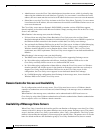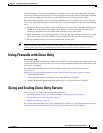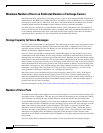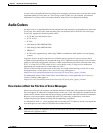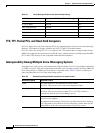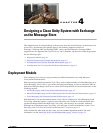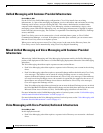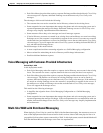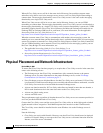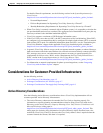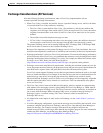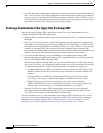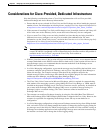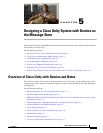
4-4
Design Guide for Cisco Unity Release 5.x
OL-14619-01
Chapter 4 Designing a Cisco Unity System with Exchange as the Message Store
Physical Placement and Network Infrastructure
When all Cisco Unity servers will be in the same Active Directory forest and the customer wants
subscribers to be able to send voice messages across servers, use Cisco
Unity Digital Networking to
connect them. The messaging functionality across Cisco
Unity servers is the same as the messaging
functionality on a single Cisco
Unity server.
When Cisco Unity servers will be in two or more Active Directory forests, you can use VPIM
networking to connect them. The messaging functionality across Cisco
Unity servers is not identical to
the messaging functionality on a single Cisco
Unity server, but most functionality is preserved. (VPIM
networking requires that the Cisco
Unity Voice Connector for Microsoft Exchange be installed on an
Exchange 2003 or Exchange 2000 server in each forest.) For more information, see the applicable
Networking Guide for Cisco
Unity Release 5.x at
http://www.cisco.com/en/US/products/sw/voicesw/ps2237/products_feature_guides_list.html.
When the customer wants Cisco Unity to communicate with another voice messaging system, the
method you use to network them and the functionality that is available depend on the voice-messaging
system. For example, to network Cisco
Unity with Cisco Unity Express or with Cisco Unity Connection,
you use VPIM networking, and to network Cisco
Unity with Octel voice-messaging systems, you use
the Cisco
Unity Bridge. For more information, see:
• The applicable Networking Guide for Cisco Unity Release 5.x at
http://www.cisco.com/en/US/products/sw/voicesw/ps2237/products_feature_guides_list.html.
• Networking Options Requirements for Cisco Unity at
http://www.cisco.com/en/US/products/sw/voicesw/ps2237/prod_installation_guides_list.html.
Physical Placement and Network Infrastructure
Revised May 6, 2008
To ensure that Cisco Unity functions properly, we require that a Cisco Unity server be in the same data
center as the following servers:
• The Exchange server that Cisco Unity communicates with, commonly known as the partner
Exchange server. For more information on the partner Exchange server, see the
“Exchange
Considerations (All Versions)” section on page 4-7.
• Every Exchange server on which mailboxes for that Cisco Unity server are homed. If Cisco Unity
is separated by a WAN from an Exchange server on which subscriber mailboxes are homed, a second
Cisco
Unity server must be co-located with the remote Exchange server.
• At least one domain controller. If Cisco Unity subscribers are homed in more than one domain, a
DC for each domain must be in the same data center as the Cisco
Unity server.
• At least one global catalog server.
• At least one DNS server.
These requirements apply regardless of whether the non-Cisco Unity servers are customer provided, or
are Cisco provided and dedicated to Cisco
Unity.
Connect the Cisco Unity server and the servers that Cisco Unity relies on with a high-speed switched
gigabit network with no congestion. Total MAPI response time must be less that 10 milliseconds.
The Cisco Unity server should be installed into the same Windows site as the Exchange servers it
services.
Note the following:
• Cisco Unity can coexist with firewalls. However, note that Cisco Unity should never be deployed
outside of a firewall. Doing so can expose the Cisco
Unity server to unwanted intrusion from the
Internet, even if the server is hardened.



